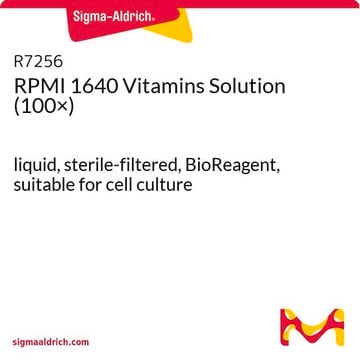M3817
MegaCell™ RPMI-1640 Medium
without L-glutamine, liquid, sterile-filtered, suitable for cell culture
Anmeldenzur Ansicht organisationsspezifischer und vertraglich vereinbarter Preise
Alle Fotos(1)
About This Item
UNSPSC-Code:
12352207
NACRES:
NA.75
Empfohlene Produkte
Sterilität
sterile-filtered
Form
liquid
Methode(n)
cell culture | mammalian: suitable
Verunreinigungen
endotoxin, tested
Komponenten
L-glutamine: no
Versandbedingung
ambient
Lagertemp.
2-8°C
Allgemeine Beschreibung
MegaCell™ is a line of versatile media, formulated to significantly reduce the amount of serum required for cultivating mammalian cells in vitro. It is effective as a basal formulation for the growth and maintenance of adherent or suspension cell lines. When supplemented with 3% fetal bovine serum (FBS), MegaCell supports proliferative rates and maximal cell densities comparable, and in some cases superior, to the conventional basal formulation supplemented with 10% fetal bovine serum.
Anwendung
MegaCell™ RPMI-1640 Medium has been used:
- as a component of the TSC medium for culturing trophoblast stem cells (TSC)
- as a component of 25 ng/ml FGF4 and 1 g/ml heparin (TSF4H medium) for culturing TSCs
- as a component of embryo-like structures (ETS) embryo medium and TS cell medium for culturing embryonic stem cells (ESCs) and TSCs
Rekonstituierung
Supplement with 4 mM L-glutamine (20 ml of 200 mM solution, G7513)
Rechtliche Hinweise
Sigma-Aldrich uses the MegaCell trademark pursuant to an agreement with Promega Corporation.
MegaCell is a trademark of Promega Corp.
Ergänzung
auch häufig zusammen mit diesem Produkt gekauft
Produkt-Nr.
Beschreibung
Preisangaben
Lagerklassenschlüssel
10 - Combustible liquids
WGK
WGK 3
Flammpunkt (°F)
Not applicable
Flammpunkt (°C)
Not applicable
Analysenzertifikate (COA)
Suchen Sie nach Analysenzertifikate (COA), indem Sie die Lot-/Chargennummer des Produkts eingeben. Lot- und Chargennummern sind auf dem Produktetikett hinter den Wörtern ‘Lot’ oder ‘Batch’ (Lot oder Charge) zu finden.
Besitzen Sie dieses Produkt bereits?
In der Dokumentenbibliothek finden Sie die Dokumentation zu den Produkten, die Sie kürzlich erworben haben.
Kunden haben sich ebenfalls angesehen
Sarah Ellys Harrison et al.
Nature protocols, 13(7), 1586-1602 (2018-07-11)
Mammalian embryogenesis requires the coordination of embryonic and extra-embryonic tissues to enable implantation into the uterus and post-implantation development to establish the body plan. Mouse embryonic stem cells (ESCs) are a useful tool for studying pluripotent embryonic tissue in vitro.
Nina S Corsini et al.
Cell stem cell, 22(4), 543-558 (2018-04-07)
Stem cell-specific transcriptional networks are well known to control pluripotency, but constitutive cellular processes such as mRNA splicing and protein synthesis can add complex layers of regulation with poorly understood effects on cell-fate decisions. Here, we show that the RNA
Berna Sozen et al.
Developmental cell, 51(6), 698-712 (2019-12-18)
Mammalian blastocysts comprise three distinct cell lineages essential for development beyond implantation: the pluripotent epiblast, which generates the future embryo, and surrounding it the extra-embryonic primitive endoderm and the trophectoderm tissues. Embryonic stem cells can reintegrate into embryogenesis but contribute
Jinhong Meng et al.
PloS one, 6(3), e17454-e17454 (2011-03-17)
Stem cell transplantation is a promising potential therapy for muscular dystrophies, but for this purpose, the cells need to be systemically-deliverable, give rise to many muscle fibres and functionally reconstitute the satellite cell niche in the majority of the patient's
Unser Team von Wissenschaftlern verfügt über Erfahrung in allen Forschungsbereichen einschließlich Life Science, Materialwissenschaften, chemischer Synthese, Chromatographie, Analytik und vielen mehr..
Setzen Sie sich mit dem technischen Dienst in Verbindung.





